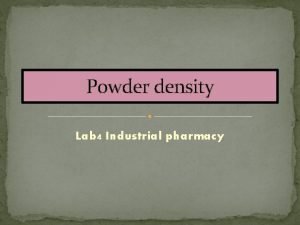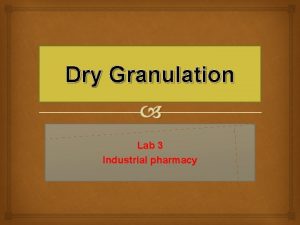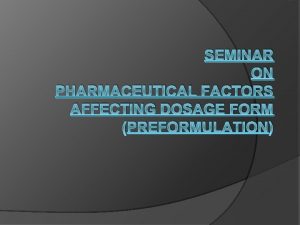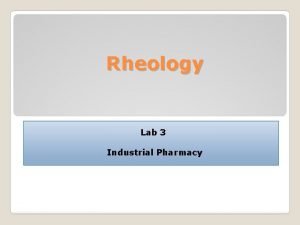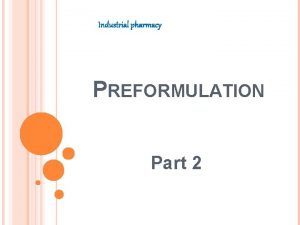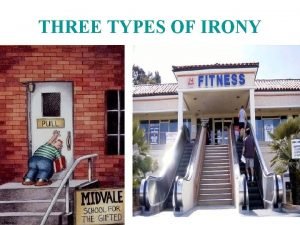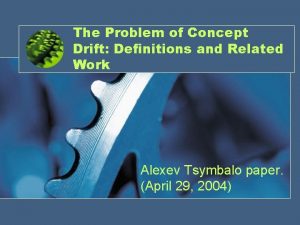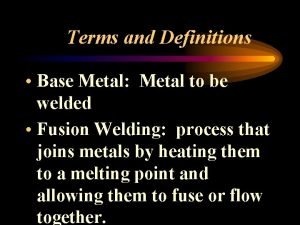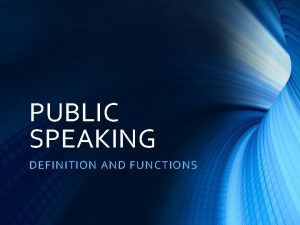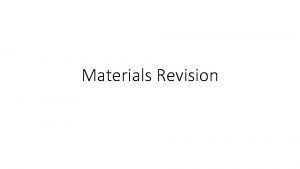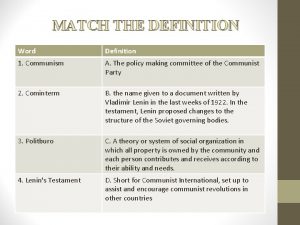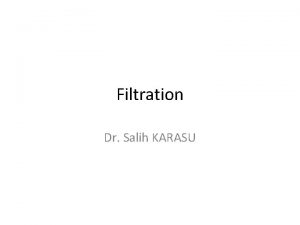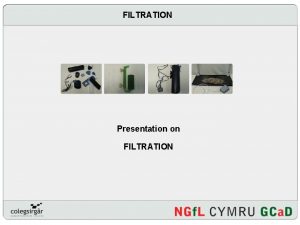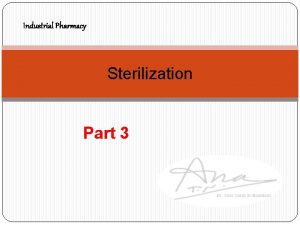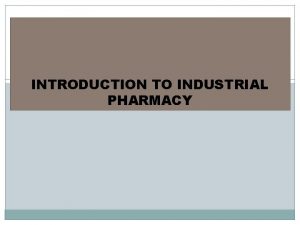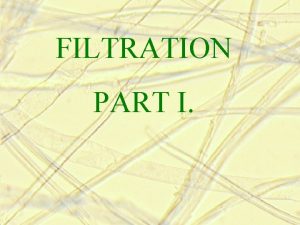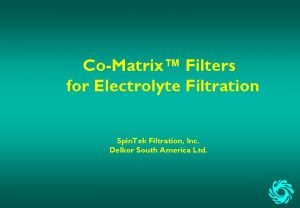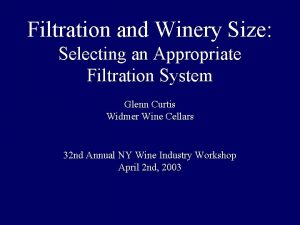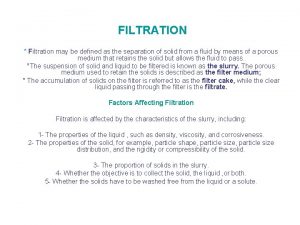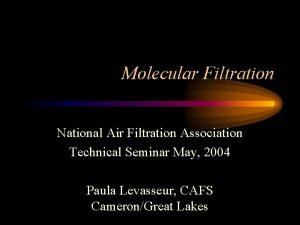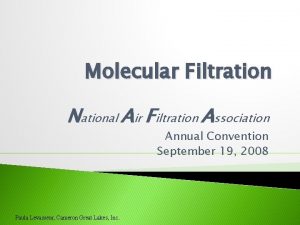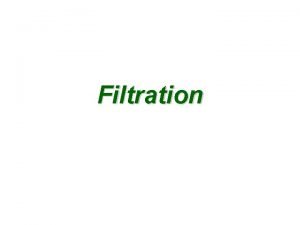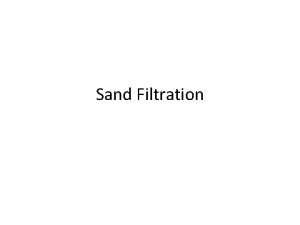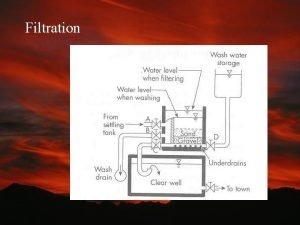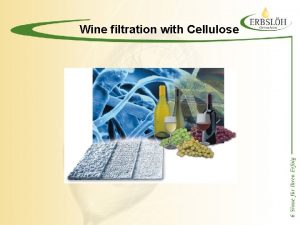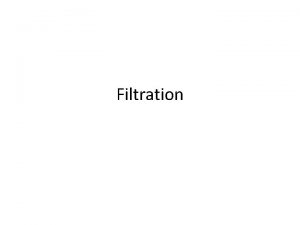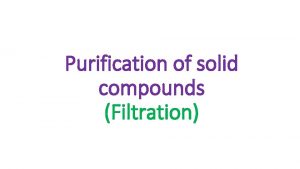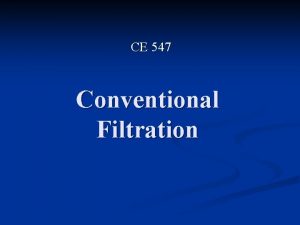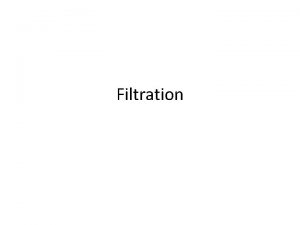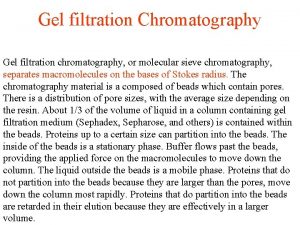Industrial pharmacy FILTRATION Part 1 Definitions Filtration process





































- Slides: 37

Industrial pharmacy FILTRATION Part 1

Definitions: Filtration: process in which particles are separated from a liquid by passing the liquid through a permeable material. Or: is a unit operation in which a mixture of solids and liquid (the feed) that is either suspension, dispersion, influent or slurry, is forced through a porous medium, in which the solids are deposited or entrapped. Filter or (porous filter medium): is the permeable material that separates particles from the liquid passing through it.

Continue definitions: Residue: the solids retained on a filter that form a cake on the surface of the medium. Effluent or filtrate: clarified liquid that is discharged from the filter. Cake filtration: the process of recovery of solids. Clarification: solids that do not exceed 1. 0% and filtrate is the primary product. Ultrafiltration: separation of intermicellar liquid from solids by the use of pressure on a semipermeable membrane.

Continue definitions: Note: Filtration is the method of choice for sterilization of solutions that are chemically or physically unstable under heating conditions. Sterile filtration: is an ideal technique for liquids and gases that is commonly used in the pharmaceutical industry. Ex: 1 - Final product solutions or vehicles for suspensions are sterile-filtered prior to an aseptic filling process. 2 - Sterile filtration of bulk drug solution prior to an aseptic crystallization process eliminates the possibility of organisms being occluded within crystals.

Industrial pharmacist must achieve a balance between: 1. Filter media 2. Equipment capabilities 3. Slurry characteristics 4. Quality specifications for the final product. All of these will lead to: choose a batch pressure filter (surface or depth filter). Depth filter: permits slurry to penetrate to a point where the diameter of a solid particle is greater than the diameter of a tortuous void or channel solids retained within a gradient density structure by physical restriction or by absorption properties of the medium. Surface filtration: screening action by which pores or holes in the medium prevent the passage of solids.

Filtration theory Estimation of resistance to flow in a clean filter medium is possible but it is impossible to estimate the resistance of filter that begins to trap solids. Different mathematical models for flow show apparent relationships between variables in a process (porous medium, cake filtration, and granular bed filtration) and their affect on the selection of apparatus and techniques for a particular filtration application. But all follow this basic rule: The energy lost in filtration is proportional to the rate of flow per unit

K= porosity constant A= S. A. of filter cake ∆P= change in pressure ϻ= viscosity of solution

Interpretation of flow rate equation:

Filter Media Filter medium (for cake filtration): the surface upon which solids are deposited in a filter. So it must retain the solids: without plugging and without excessive bleeding of particles at the start of the filtration. Note: In clarification applications (no appreciable cake is developed) the medium is the primary factor to remove all particles above a desired size and achieve clarity. Sterile filtration carry out a special requirement: 1 - pore size must not exceed the dimension of M. O. unless the filter is adsorptive 2 - medium should be sterilizable.

Types of filter media: 1. a) Filter cloth: (surface type medium) is woven from either natural or synthetic fiber or metal. Natural: Cotton fabric (most common and widely used as a primary medium), as backing for paper or felts in plate and frame filters and as fabricated bags for coarse straining. Synthetic fiber: Nylon (superior for pharmaceutical use) Properties: (unaffected by mold, fungus, or bacteria) (provides an extremely smooth surface for good cake discharge) (has b)

Note: Both cotton and nylon are suitable for coarse straining in aseptic filtrations: since they can be sterilized by autoclave. Monofilament nylon cloth is extremely strong and is available for openings as small as 10 microns. Teflon (superior for most liquid filtration)…chemically inert, provides sufficient strength, and can withstand elevated temp.

c. Woven wire cloth (stainless steel) Properties: durable, resistant to plugging, easily cleaned and repeatedly sterilized. Uses: remove small amounts of unwanted solids from liquids (clarification) such as milk, syrup, sulfuric acid, and hot caustic soda. 1. 2. Metallic filter media: provide good surfaces for cake filtrations and used with filter aids. wire screens: used as support elements for disposable media since they may be cleaned rapidly and returned to service. Wire mesh filters: installed in filling lines of packaging equipment. Function: is the security against the presence of large foreign particles. 3.

2. Nonwoven filter media Types: (felts, bonded fabrics, and kraft papers). A felt (fibrous mass that is either natural or synthetic) free from bonding agents and mechanically interlocked to yield specific pore diameters that have controlled particle retention. Properties: 1 - High flow rate with low pressure drop 2 - Function as depth media 3 - Recommended for gelatinous solutions or fine particulate matter. a. Bonded fabrics made by binding textile fibers with resins, solvents, and plasticizers. Not used widely in dosage form production b.

Kraft paper (pharmaceutical standard). Uses: limited use in plate and frame filters and horizontal-plate filters. Properties: Controlled porosity, limited absorption characteristic, low cost and disposable medium. c. Example: White papers (preferred, due to crinkles that produce greater filtration area). Note: support of cloth or wire mesh is necessary in large filter presses to prevent rupture of the paper with pressure.

3. Membrane filter media

Important Notes:

4. cartridge units Uses: remove low percentages of solids (100 ϻ <0. 2 ϻ) in particle size (economical and convenient). Types: surface or depth filter (consists of a porous medium integral with plastic or metal structural hardware). Disposable cartridges: manufacture from synthetic and natural fibers, cellulose esters and fiberglass, fluorinated H. C. polymers, nylon, and ceramics. cleanable and reusable cartridges: manufacture from stainless steel, Monel, ceramics, fluorinated H. C. polymers, and exotic metals.

A- Surface-type cartridges Are wavy, resin treated paper. Used: hydraulic lines of processing equipment. Not used: finished products. 1. 2. 3. 4. Ceramic cartridges is cleanable for reuse by back flushing. Porcelain filter candles used for sterile filtrations with membrane filters in cartridge form. Sintered metal or woven-wire elements are also useful, but fine wire mesh lacks strength. metallic-edge filters overcome this problem by allowing liquid to pass between rugged metal strips, which are separated by spacers of predetermined thickness.

B- Depth-type cartridges It is disposable and consist of fibrous media (cotton, asbestos, or cellulose). Manufacturing: 1. 2. Felting or by resin bonding fibers about a shaft. Or twisting fibers around a central supporting screen.

Filter Aids Review notes: i. The rate of filtration is inversely proportional to the resistance of the solids cake, the density of the liquid and square of the particle diameter. ii. iii. The pressure drop across the system is directly proportional to the filtration rate, thickness of the cake, and liquid viscosity for flow through porous media, when laminar flow conditions exist in the filter media or cake. Poorly flocculated solids offer higher resistance than deflocculated solids or solids providing high porosity to the cake.

Problems: 1. 2. When volume of the filter cake solids/volume of filtrate is low the solids formed on the filter medium may penetrate the void space filter medium more resistant to flow. At a higher concentration of solids in a suspension Bridging over of openings over the void space, rather than blinding of the openings. Slimy or gelatinous materials, or highly compressible substances, form impermeable cakes with high resistance to liquid flow. The filter medium becomes plugged or slimy with accumulation of solids, and flow of filtrate stops. Filter aid is needed as a solution for all of these 3 problems. 3.

Filter aids: special type of filter medium. v Filter aid forms a fine surface deposit screens out all solids preventing them from contacting and plugging the supporting filter medium. Mechanism: acts by forming a highly porous and noncompressible cake that retains solids, as does any depth filter. v The duration of a filtration cycle and the clarity attained can be controlled as density, type, particle size, and quantity of the filter aid are varied.

How the quantity of the filter aid greatly influences the filtration rate: If too little filter aid is used resistance offered by the filter cake is greater than if no filter aid is used (because of added thickness to the cake). If high amounts of filter aid are added filter aid merely adds to the thickness of the cake without providing additional cake porosity.

In this figure: The flow rate and permeability are directly proportional to each other. At low conc. of filter aid, the flow rate is slow because of low permeability. As the filter aid concentration increases, the flow rate increases and peaks off. Beyond this point, the flow rate decreases as the filter aid conc. is increased.

Ideal Filter Aid The ideal filter aid performs its functions physically or mechanically; no absorption or chemical action is involved in most cases. The important characteristics for filter aids are the following: 1. It should have a structure that permits formation of pervious cake. 2. It should have a P. S. distribution suitable for the retention of solids. 3. It should be able to remain suspended in the liquid. 4. It should be free of impurities. 5. It should be inert to the liquid being filtered. 6. It should be free from moisture in cases where the addition of moisture to the fluid would be undesirable. 7. It should be insoluble, incompressible, and irregularly shaped.

Filter aids are classified: 1. 2. From low flow rate (fine: mean size in the range of 3 to 6 microns) to fast flow rate (coarse: mean size in the range of 20 to 40 microns). Note: Clarity of the filtrate is inversely proportional to the flow rate, and selection requires a balance between these factors.

(Inert and insoluble) (Has irregular shape porous particle that form incompressible cake) (costy and toxic) (Highly compressible)

Application of Filter aid Applied by precoating or bodymix techniques. 1. Precoating requires: (suspending the filter aid in a liquid and recirculating the slurry) until the filter aid is uniformly deposited on the filter septum. The quantity varies from 5 to 15 pounds per 100 square feet of filter area, or that sufficient to deposit a cake 1/16 to 1/8 inches thick. The liquid is preferably a portion of the feed or retained filtrate from a prior cycle, since the physical properties of the precoat liquid must approximate those of the material to be filtered. Precoating should proceed at the same flow rates and pressures to be used in final filtration, and the transition from precoat liquid to regular feed must be rapid to

2. Body mix (direct addition of filter aid to the filter feed) [common in batch pharmaceutical operations]. Mechanism: The filter aid, 1 to 2 pounds per pound of contaminant, or 0. 1 to 0. 5% of total batch weight, is mixed into the feed tank. This slurry is recirculated through the filter until a clear filtrate is obtained; filtration then proceeds to completion. Benefit: minimizes equipment requirements and crosscontamination potentials.

Disadvantage of Filter aid: Filter aid may be used that performs its function not physically or mechanically, but chemically, by reacting with the solids depositing in a filter bed to adhere more strongly to the filter medium. What’s the solution: Water-soluble polymers (flocculating agents) used as filter aids. Theses polymers may be: 1 - Derived from vegetable or animal sources (starch) 2 - Produced synthetically (nonionic, anionic, or cationic) Ex: commercially available water-soluble cationic polymers (acrylamide copolymers, polyethyleneimine, and guar gum).

v In pharmaceutical operations the selection usually favors the fine grades, which yield low flow rates. Disadvantage no. 2: Filter aid may have absorption properties Desired colored substances and active principles are frequently removed. The viscosities of most liquids decrease with increase in temperature and as the (inverse relationship of flow rate to viscosity) so filtration efficiency affected by changes in temp. The viscosity of a liquid increases as the pressure is increased (due to the number of holes is reduced, it is more difficult for molecules to move around).

Important notes: Most liquids must be maintained at a high temp. during filtration: to prevent the formation of crystals. So filtration at room temperature would yield a liquid that might cloud at the lower temperatures. 1. 2. Filtration of cosmetic products at low temperatures (5°C) due to consequent reduction in flow rate is tolerated, since the goal is reduced solubility of contaminants or perfume oils, resulting in their more effective removal.

Filter Selection In designing or selecting a system for filtration, the specific requirements of the filtration problem must be defined: 1. What is to be filtered-liquid or gas? 2. What liquid or gas is to be filtered? 3. What is the pore size required to remove the smallest particle? 4. What is the desired flow rate? 5. What will the operating pressure be?

6. What are the inlet and outlet plumbing connections? 7. What is the operating temperature? 8. Can the liquid to be filtered withstand the special temperature required? 9. What is the intended process-clarification or filtration? 10. Will the process be a sterilizing filtration? 11. Will the process be a continuous or batch filtration? 1'2. What is the volume to be filtered?

The selection of the filter medium can be made depending on: For example: i. Sterilizing filtration (0. 2 -micron pore size is used). ii. Clarification (plate and frame filter or wovenfiber filter may be used). iii. The filter medium should be compatible with the liquid or gas to be filtered. iv. Filter type: a. b. Filter resist aggressive ingredients in liquid: cellulose, polytetrafluoroethylene (PTFE), fiber, metal, polyvinylidene difluoride, nylon, or polysulfones For vent filters or gaseous filtration: a hydrophobic filter medium should be chosen.

Filtration surface area is calculated (after the filter media, pore size, required flow rate, and pressure differentials are established). vi. Liquid viscosity. vii. Gaseous filtration at high temp and exit pressures. viii. In optimum system using a series of filters in a single multilayered filter containing layers of various pore sizes or a prefilter followed by a final filter. ix. Optimum performance is obtained when the filters in a series exhaust their dirt-holding capacities at the same time. x. Using prefilter in combination with a final filter to perform the efficiency of the prefilter as maximum. If a final filter that is not protected by prefilter then it will has a short filter life. v.

 Filtration introduction
Filtration introduction Bulkiness in pharmacy
Bulkiness in pharmacy Slugging in granulation
Slugging in granulation Preformulation definition in pharmacy
Preformulation definition in pharmacy Powder rheology lab
Powder rheology lab Industrial pharmacy lab
Industrial pharmacy lab Industrial pharmacy lab
Industrial pharmacy lab Preformulation studies in industrial pharmacy
Preformulation studies in industrial pharmacy Part part whole addition
Part part whole addition Part to part ratio definition
Part to part ratio definition Part part whole
Part part whole Define technical description
Define technical description What are the parts of a bar
What are the parts of a bar The part of a shadow surrounding the darkest part
The part of a shadow surrounding the darkest part 미니탭 gage r&r 해석
미니탭 gage r&r 해석 In an industrial process nitrogen is heated to 500k
In an industrial process nitrogen is heated to 500k Thinking definition
Thinking definition 3 kinds of irony
3 kinds of irony The problem of concept drift: definitions and related work
The problem of concept drift: definitions and related work Striker welding definition
Striker welding definition Cheek cut rafter
Cheek cut rafter Ankle dorsiflexion rom goniometry
Ankle dorsiflexion rom goniometry Public speaking meaning
Public speaking meaning Education psychology definition
Education psychology definition Overall rag status
Overall rag status Definitions of poverty
Definitions of poverty What is verbal communication
What is verbal communication Micro teach meaning
Micro teach meaning Material properties and definitions
Material properties and definitions Collectivisation definition
Collectivisation definition Leader ka meaning
Leader ka meaning Define human rights
Define human rights Definiton of plot
Definiton of plot Plot meaning in story
Plot meaning in story Build your vocabulary find these words in the text
Build your vocabulary find these words in the text Picture of radius of a circle
Picture of radius of a circle What is gothic novel definition
What is gothic novel definition What are the news values
What are the news values

